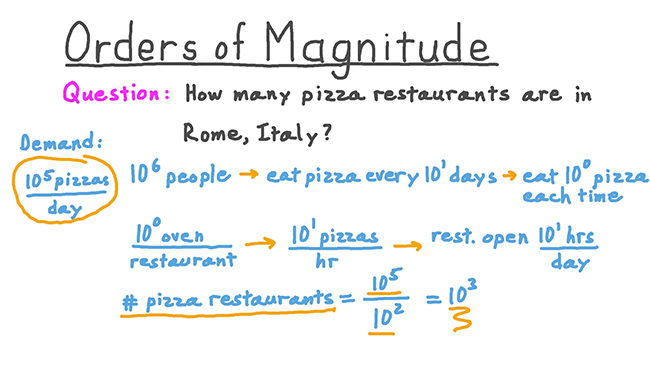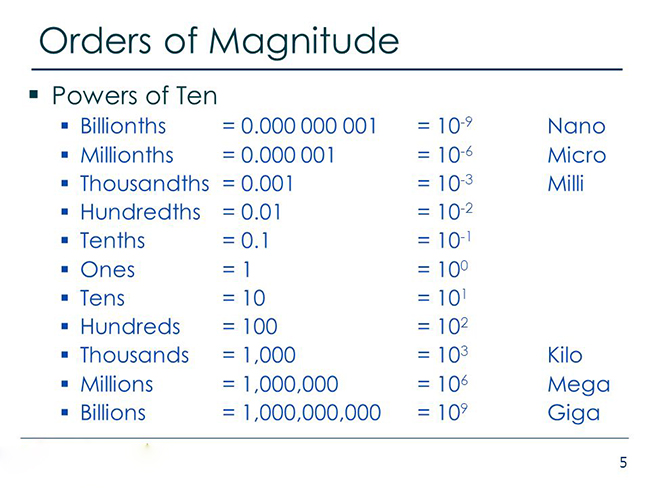In order to compare the measured values of physical quantities, we make use of the idea of the order of magnitude.
The power, when the magnitude of a physical quantity is expressed in terms of the nearest power of ten, is called the order of magnitude. Instead of knowing the actual value of a physical quantity, in many cases, it is sufficient to know only the order of magnitude of that quantity. Order-of-magnitude helps us to write numbers that are too large or too small in a standard or convenient form and are commonly used by scientists, mathematicians, engineers etc.
Contents
How do you calculate the order of magnitude?


The order of magnitude of a numerical value N is 𝑥, such that
That is, in order to find the order of magnitude of a quantity, it is first expressed as the power of 10 with the numerical part or coefficient should be greater than 0.5 and less than or equal to 5. Then the power of 10 is usually called as the order of magnitude of that quantity. It can be any integer.
The order of magnitude of all the numerical numbers can be calculated in the same way as given below.
- The number 72 can be expressed as
. That is, it becomes 0.5 < 0.72 ≤ 5. Therefore, the order-of-magnitude of the numerical number 72 is 2.
- Similarly, the number 5234 can be expressed as
. That is, it becomes 0.5 < 0.5234 ≤ 5. Therefore, the order of magnitude of the numerical number 5234 is 4.
- Consider the number 4234. It can be expressed as
. That is, it becomes 0.5 < 4.234 ≤ 5. Therefore, the order-of-magnitude of the numerical number 4234 is 3.
- Consider the number 0.35. It can be expressed as
. That is, it becomes 0.5 < 3.5 ≤ 5. Therefore, the order-of-magnitude of the numerical number 0.35 is -1.
- The number 0.74 can be expressed as
. That is, it becomes 0.5 < 0.74 ≤ 5. Therefore, the order of magnitude of the numerical number 0.74 is 0.
- Consider the number 0.95. It can be expressed as
. That is, it becomes 0.5 < 0.95 ≤ 5. Therefore, the order-of-magnitude of the numerical number 0.95 is 0.
- The number 0.035 can be expressed as
. That is, it becomes 0.5 < 3.5 ≤ 5. Therefore, the order-of-magnitude of the numerical number 0.035 is -2.
- Consider the number 0.065. It can be expressed as
. That is, it becomes 0.5 < 0.65 ≤ 5. Therefore, the order-of-magnitude of the numerical number 0.035 is -1.
Similarly, we can write the order-of-magnitude for all numbers. The order of magnitudes of some numerical numbers is given below.
| Number | Expressed in nearest power of 10 | Order of magnitude |
| 1 | 100 | zero |
| 6 | 0.6 × 101 | 1 |
| 28 | 2.8 × 101 | 1 |
| 46 | 4.6 × 101 | 1 |
| 63 | 0.63 × 102 | 2 |
| 94 | 0.94 × 102 | 2 |
| 289 | 2.89 × 102 | 2 |
| 431 | 4.31 × 102 | 2 |
| 541 | 0.541 × 103 | 3 |
| 832 | 0.832 × 103 | 3 |
| 2348 | 2.348 × 103 | 3 |
| 6859 | 0.6859 × 104 | 4 |
| 0.03 | 3 × 10-2 | -2 |
| 0.06 | 0.6 × 10-1 | -1 |
| 0.00047 | 4.7 × 10-4 | -4 |
Table 1: Order-of-magnitude of some numerical numbers
Order of magnitude of length
The sizes of the objects, we come across in the universe, may vary over a wide range of the order of 10-14 m of the tiny nucleus of an atom to the size of the range of 1026 m of the extent of the observable universe. The size and order of lengths of some of these objects are given in the below table 2.
| Sl.No | Size of object or distance measured | Order of length (m) |
| 1. | The radius of a proton | 10-15 |
| 2. | Size of the atomic nucleus | 10-14 |
| 3. | Size of the hydrogen atom | 10-10 |
| 4. | Size of poliomyelitis virus | 10-8 |
| 5. | Wavelength of light | 10-7 |
| 6. | Size of red blood corpuscle | 10-5 |
| 7. | Thickness of paper | 10-4 |
| 8. | The height of a person | 100 |
| 9. | The height of Mount Everest above sea level | 104 |
| 10. | The radius of the moon | 106 |
| 11. | Radius of earth | 107 |
| 12. | Mean distance of the moon from earth | 108 |
| 13. | Radius of sun | 109 |
| 14. | Mean distance of the sun from earth | 1011 |
| 15. | The distance of Pluto from the sun | 1013 |
| 16. | The distance of our galaxy (Milky Way) | 1020 |
| 17. | The distance of nearest galaxy(Andromeda) to Milky Way | 1022 |
| 18. | Distance to the boundary of the observable universe | 1026 |
Table 2: Range and order of lengths
Order of magnitude of mass
Mass is a basic property of matter and its SI unit is kilogram. The mass of a body does not depend on the temperature, pressure or location of the object in space. The masses of the objects, we come across in the universe, may vary over a very wide range of the order of a tiny mass of 10-30 kg of an electron to the huge mass of about 1055 kg of the known universe. The range and order of the typical masses of various objects are given in the below table 3.
| Sl.No | Object | Mass (kg) |
| 1. | Electron | 10-30 |
| 2. | Proton | 10-27 |
| 3. | Uranium atom | 10-25 |
| 4. | Red blood cell | 10-13 |
| 5. | Dust particle | 10-9 |
| 6. | Raindrop | 10-6 |
| 7. | Mosquito | 10-5 |
| 8. | Grape | 10-3 |
| 9. | Human | 102 |
| 10. | Automobile | 103 |
| 11. | Moon | 1023 |
| 12. | Earth | 1025 |
| 13. | Sun | 1030 |
| 14. | Milky way galaxy | 1041 |
| 15. | Observable universe | 1055 |
Table 3: Range and order of masses
Order of time intervals
To measure any time interval we need a clock. We now use an atomic standard of time, which is based on the periodic vibrations produced in a caesium atom. This is the basis of the caesium clock, sometimes called an atomic clock. The time interval of events that we come across in the universe varies over a very wide range. The range and order of some typical time intervals are given in the below table 4.
| Sl.No | Event | Time interval (s) |
| 1. | Life – span of most unstable particle | 10-24 |
| 2. | The time required for light to cross a nuclear distance | 10-22 |
| 3. | Period of X – rays | 10-19 |
| 4. | Period of atomic vibrations | 10-15 |
| 5. | Period of the light wave | 10-15 |
| 6. | The lifetime of an excited state of an atom | 10-8 |
| 7. | Period of radio wave | 10-6 |
| 8. | Period of the sound wave | 10-3 |
| 9. | Wink of eye | 10-1 |
| 10. | The time between successive human heart beats | 100 |
| 11. | Travel time for light from the moon to the Earth | 100 |
| 12. | Travel time for light from the sun to the Earth | 102 |
| 13. | The time period of a satellite | 104 |
| 14. | The rotation period of the Earth | 105 |
| 15. | Rotation and revolution periods of the moon | 106 |
| 16. | Revolution period of the Earth | 107 |
| 17. | Travel time for light from the nearest star | 108 |
| 18. | Average human life – span | 109 |
| 19. | Age of Egyptian pyramids | 1011 |
| 20. | Time since dinosaurs became extinct | 1015 |
| 21. | Age of the universe | 1017 |
Table 4: Range and order of time intervals
Solved Examples
1. Write the order of magnitude of the given numbers from smallest to biggest:
0.7 0.004 0.04 1 3.54 0.1 11.5 0.4 0.008 57 0.00089 0.05
Answer:
Number Expressed in nearest power of 10 Order of magnitude 0.7 0.7 × 100 0 0.004 4 × 10-3 -3 0.04 4 × 10-2 -2 1 1 × 100 0 3.54 3.54 × 100 0 0.1 1 × 10-1 -1 11.5 1.15 × 101 1 0.4 4 × 10-1 -1 0.008 0.8 × 10-2 -2 57 0.57 × 102 2 0.00089 0.89 × 10-3 -3 0.05 5 × 10-2 -2 The order-of-magnitude of numbers can be written from smallest to biggest as
0.00089 0.004 0.008 0.04 0.05 0.1 0.4 0.7 1 3.54 11.5 57
2. What will be the order of magnitude of 105+103
Ans:
The resultant order-of-magnitude will be the highest order which is added, i.e, here the resultant order of magnitude will be 5.
Let’s verify,
105+103 = 100000 + 1000
= 101000
= 1.01 × 105
i.e., the order of magnitude is 5.
3. Find the order of magnitude of the sum of 586482 and 745899.
Ans:
586482 + 745899 = 1332381
= 1.332381 × 106
i.e., the order of magnitude is 6.
4. Find the order of magnitude of the product of 2456 and 127.
Ans:
24563 × 127 = 3119501
= 3.119501 × 106
i.e., the order of magnitude is 6.
5. Find the order of magnitude of the acceleration due to gravity.
Answer:
We know, acceleration due to gravity, g = 9.8 m/s2
i.e., g can be expressed as 0.98 × 101 m/s2
Therefore, order of magnitude of acceleration due to gravity, g = 1
6. Find the order of magnitude of the Gravitational constant.
Answer:
We know, Gravitational constant, G = 6.673 x 10-11 Nm2kg-2
i.e., G can be expressed as 0.6673 x 10-10 Nm2kg-2
Therefore, the order of magnitude of gravitational constant, G = –10
7. Find the order of magnitude of the Faraday’s constant.
Answer:
We know, Faraday’s constant, F = 9.648 x 104 C/mol
i.e., F can be expressed as 0.9648 x 105 C/mol
Therefore, the order of magnitude of Faraday constant, F = 5
8. A school is having 6314 students. What is the order of magnitude of the number of students?
Answer:
Number of students = 6314
i.e., it can be represented as 0.6314 x 104
Therefore, the order of magnitude = 4
I hope the information in this article helps you to get a brief idea about the order of magnitude, and if you believe I missed something or if you have any suggestions, do let me know via comments.
Also if you find this article useful, don’t forget to share with your friends and colleagues on Facebook and Twitter.
Also, learn significant figures and rounding off with the help of solved examples.

